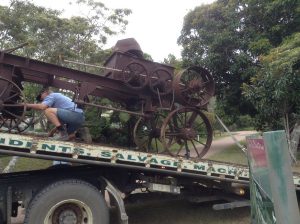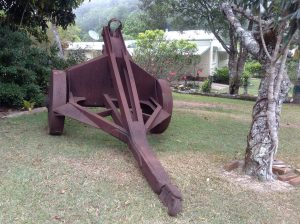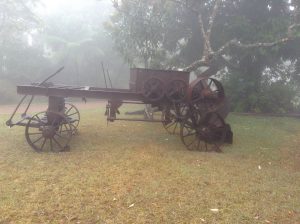 On Friday 12th October, two new arrivals appeared on the lawns adjoining Lennox Crescent and Mount Spec Road. They emerged from a dense cloud mist which enveloped Paluma that day, like visitors from the mists of time. The ambience seemed fitting, as these new arrivals are relics of a bygone era; a timber hauler, which was used to haul timber on Mt Spec and a bitumen mixer used in surfacing the Range Road during the 1950’s. The large, solid steel machines are well preserved and represent the epitome of engineering design and workmanship of their day.
On Friday 12th October, two new arrivals appeared on the lawns adjoining Lennox Crescent and Mount Spec Road. They emerged from a dense cloud mist which enveloped Paluma that day, like visitors from the mists of time. The ambience seemed fitting, as these new arrivals are relics of a bygone era; a timber hauler, which was used to haul timber on Mt Spec and a bitumen mixer used in surfacing the Range Road during the 1950’s. The large, solid steel machines are well preserved and represent the epitome of engineering design and workmanship of their day.
The machines were for many years kept on a property on Spiegelhauer Road until Wilfred Karnoll acquired them and brought them up the Range on a tilt-tray to their new home on Mount Spec Road. Appropriately, they are sited on the lawns of the former Cavilcade Guest House, which was built in the late 1930’s by Bert and Grace Cavill. The house is a historic landmark building in Paluma, and in its heyday in the 1930’s, accommodated tourists who travelled up the newly constructed road.
The former owner of these machines is Mrs Helen Davies whose late husband operated the timber hauler for dragging logs from the forests in the Paluma area. The timber hauler is a Campbell bob-tail, No 122, manufactured by A.B. Campbell Engineering in Gloucester, NSW. It was  towed behind a small bulldozer. A steel rope from the winch on the dozer ran over the pulley on the bob-tail. By retracting the winch rope the heavy end of the log would be lifted off the ground and dragged out of the scrub to the loading ramps. The logs would then be loaded onto trucks towing timber jinkers for transport to saw mills or the rail siding at Moongobulla.
towed behind a small bulldozer. A steel rope from the winch on the dozer ran over the pulley on the bob-tail. By retracting the winch rope the heavy end of the log would be lifted off the ground and dragged out of the scrub to the loading ramps. The logs would then be loaded onto trucks towing timber jinkers for transport to saw mills or the rail siding at Moongobulla.
The bitumen mixer was originally owned by the Main Roads Commission; its serial number is MRC 2776. There is no marking to indicate its age or the foundry in which it was built. The machine was used in the surfacing of the Range road in the 1950’s.  Until then the road was unsealed. The bitumen mixer carried a drum that had two sets of paddles running through it which mixed the liquid hot tar with sand and gravel to produce bitumen for sealing the road. Unfortunately the engine driving the mixer via two leather belts, is missing. Possibly it was a Southern Cross engine, one of which may eventually be obtained and set in place.
Until then the road was unsealed. The bitumen mixer carried a drum that had two sets of paddles running through it which mixed the liquid hot tar with sand and gravel to produce bitumen for sealing the road. Unfortunately the engine driving the mixer via two leather belts, is missing. Possibly it was a Southern Cross engine, one of which may eventually be obtained and set in place.
On the left side of the Range road, (going down) near The Saddle, are two steel tanks which were used to liquefy the tar. These may be hard to locate, obscured as they are by long grass.
It is satisfying to have in the village these two solid reminders of Paluma’s past. They complement the photographic history on display in the Community Hall of the industries, the people and the development of this area.
Text and photos by Colwyn Campbell
